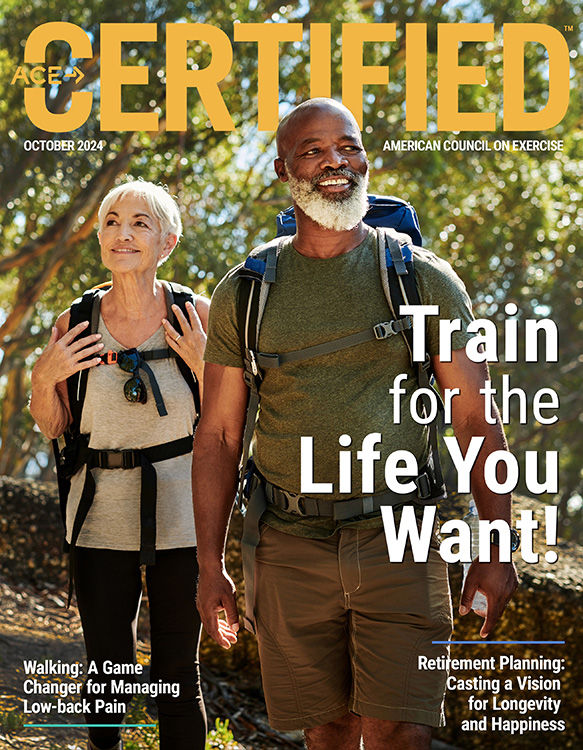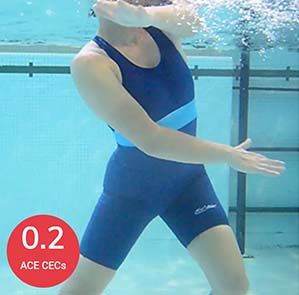
Key Takeaways
- Mobility is crucial for safe, effective movement in exercise and daily life. CARs help identify and improve active ranges of motion, ensuring clients move more efficiently and with reduced injury risk.
- By training connective tissues and joints for specific ranges of motion, CARs can help clients better handle the physical demands of sports and exercise, reducing the likelihood of injury.
- CARs provide qualitative and quantitative data about joint health, which can guide health and exercise professionals in tailoring programs to improve mobility and joint function.
- While CARs assessments require specific certification, health and exercise professionals can introduce basic CARs concepts and movements into warm-ups, cool-downs and mobility routines without overstepping professional boundaries.
Adequate mobility is a prerequisite for the performance of just about any exercise or movement. No big secret there. It’s the reason why the Muscular Training component of the ACE Integrated Fitness Training® Model begins with Functional Training, which focuses on establishing or reestablishing postural stability and kinetic chain mobility, before moving on to Movement Training and finally to Load/Speed Training. A lot of work has to be done by a client before external loads are added to exercises in that final phase.
Imagine you have a new client who says they have experience with muscular training and wants to include barbell squats in their routine. In your initial sessions, you note that their heels lift off the floor as they move into the lowest point of their squat, indicating that they lack the dorsiflexion needed at the ankles to perform a body-weight squat with proper form. While they may have the required strength in their quadriceps and glutes to perform barbell squats, the undue strain placed on the connective tissue in the ankles could lead to injury over time. The first step in this process must be the development of the prerequisite mobility at the ankle.
Now, imagine this scenario when working with athletes or more active clients who perform countless movements on a daily basis. The ability to throw effectively for a college baseball or softball pitcher, for instance, begins with the ability to move the shoulder through a full range of motion, not to mention the movements taking place at other joints as they rotate their hips, push off the mound and stride toward home plate. Weekend warriors playing pickleball, as another example, must have the mobility to sprint forward, backpedal and swing their arms at various angles, including overhead.
All clients, not only athletes, would likely benefit from a more thoughtful and purposeful approach to mobility training, and this is where controlled articular rotations—better known as CARs—come into play.
Mobility 101
Alex Nichols, strength coach and manual therapist, owner of The Art of Strong and an instructor for Functional Range Systems (FRS), explains that understanding CARs begins with an exploration of the definition of the term “mobility.”
“Mobility is active, usable ranges of motion that you can control and that you can manage force in,” Nichols explains. “This is different from passive range of motion.”
In any sport or physical activity, you are going to be moving through active ranges of motion and placing stress by way of force on various tissues. So, if you have a deficit in your active range of motion at a particular joint that originates from the connective tissue, that is something that can be identified through CARs.
Consider a scenario where a client is playing third base, whether for the Los Angeles Dodgers or in a recreational softball league. At times, they will likely find themselves fielding ground balls in awkward positions and then using muscular strength and power to throw the ball across the diamond from an unusual angle, not to mention taxing the joints and connective tissues.
The idea behind CARs is that it provides quantitative and qualitative data to the athlete about how much active range of motion they have at each joint. Are they experiencing pain, pinching or compensation during their CARs? This can be an indicator of the health and mobility of the joint. With specific outcome measures and a thought process outlined in a Functional Range Conditioning seminar (see sidebar, below), a CARs provider can outline a personalized approach. With this information, you as a personal trainer can offer personalized modifications to the athlete’s training program.
In other words, if a client has trained each of their joints to move through their full ranges of motion, this allows the potential to then specifically train that joint for the demand of the sport of baseball. That means that when they find themselves in those awkward position, they will have spent time training specific tissue capacities in specific ranges of motion, and thus will have more of a buffer to mitigate injuries because they will have been in those positions before. Their shoulders, hips, ankles and elbows will not have to compensate as much and be exposed to untrained positions to perform the motions of their sport.
Defining CARs
As Dr. Andreo Spina, the creator of CARs, explains, “CARs is an expression of what a joint is capable of doing.”
As you can probably piece together from the name, CARs involve slow and deliberate rotational movements at the joints—or articulations—with the goal of moving each joint through its full, pain-free range of motion in all directions, through all planes of motion around the entire axis of rotation, specific to each joint. “The idea,” says Chris Gagliardi, MS, ACE Scientific Education Content Manager, “is to increase the amount of usable motion at each joint by actively moving the joint in a controlled manner without using momentum or swinging your limbs. Each movement, in each direction, is intentional and done with control.”
So, rather than having a client with tightness in the shoulder, for example, perform arm circles to warm up the joints, performing CARs involves eliminating momentum and moving the limb through the full range of each of its possible motions with intention and purpose. Importantly, CARs is also valuable as a joint-specific screening and maintenance tool.
The benefit, Gagliardi explains, comes from actively, rather than passively, moving the joint. On any given day, he explains, we typically move our joints within a limited range of motion. Over time, that range becomes increasingly limited. “If you don’t use the full range of motion, you will lose the full range of available motion,” says Gagliardi. “CARs allow you to progressively restore the usable range of motion.”
CARs can be more easily understood if the discussion is broken down into two types or levels. The first involves an individualized approach that should be conducted only by someone who has undergone the education and training to do so properly (see sidebar, below). At this level, the professional is conducting assessments and learning about each client’s lifestyle and health history, and then offering personalized programming to address that client’s needs, which typically involve injury prevention and/or management. The fitness industry equivalent is a personal trainer who works one on one with clients and has the time and insight needed to help them achieve health, fitness and performance goals that align with their values and needs.
The second level is more equivalent to a group fitness instructor, who faces a room full of participants all interested in improving their fitness, but about whom the instructor may know very little. The participants may include the college pitcher and weekend pickleball player mentioned earlier, alongside a power lifter, an avid hiker and a gym member who wandered in to try something new.
This second level is the type of CARs you might consider offering to your clients, as, unless you earn the needed certificate, you are not qualified to offer injury assessments and personalized CARs programming. Never lose sight of the fact that it is outside the scope of practice of a health coach or exercise professional to diagnose or treat an injury. Instead, you can introduce CARs concepts and movements, explain their purpose to clients and integrate them into their training programs. At this level, it’s more about maintaining current mobility at tight joints or even globally than it is about addressing specific injuries.
“Teaching your clients about CARs and adding them as part of a warm-up or cool-down routine is within the scope of practice of an exercise professional,” explains Gagliardi. “As an exercise professional you should have a general understanding of which motions occur at each joint and CARs are a practical way to move the body with the intention of becoming more mobile.”
Personal trainers might also introduce CARs after conducting mobility assessments with new clients. If you observe any issues during a bend-and-lift assessment, for example, that indicate movement limitation or compensation around a joint, you might introduce a client to CARs for that joint.
Just like other exercise modalities, professionals should be educated on the use of CARs prior to instructing clients on their use so that they can efficiently integrate this tool into their practice in a seamless way. While attending a CARs-specific training may not be something everyone has the opportunity to do, there are plenty of resources available online to learn more about this technique and view samples of CARs movements. See the sidebar for information on taking seminars with Dr. Andreo Spina.
Functional Range Conditioning
If you are interested in learning more about CARs, consider earning a certificate through FRS. CARs is just one element of their Functional Range Conditioning (FRC) program, which teaches mobility development, joint strength and body control. Developed by Dr. Andreo Spina, this is a two-day seminar (offered both live and online) designed for health and exercise professionals that includes lectures laying the scientific and evidence base, as well as active practice in a gym setting.
CARs in Action
Alex Murphy is a physical therapist and clinic owner and currently holds six certificates from FRS, including Functional Range Release, Functional Range Conditioning and Kinstretch. Murphy has a fantastic YouTube channel where she offers both full-length classes and video tutorials with tips to help people improve their joint health, mobility and movement quality. The video below features a head-to-toe daily CARs routine that you can use to experience CARs for yourself and learn how to execute them correctly to facilitate your ability to share CARs with your clients. Additionally, you can share this link with clients as a resource to use between sessions with you. In the video caption, you’ll find individual exercise tutorials for each articulation, as well as links to Murphy’s online programs.
Final Thoughts
CARs is about both injury mitigation and improved athletic performance. While you can’t diagnose injuries or explore connective tissue and joint health in the way that Nichols might with his clientele, you can still incorporate CARs, whether it’s for a specific joint or a full-body program, into your repertoire of services. Just be mindful of your own limitations and level of education on the topic. After all, you wouldn’t lead a yoga or Pilates session after watching a handful of videos online or on social media, so treat CARs with that same level of respect.
Nichols explains that CARs allow you to determine exactly where you need to be training your clients’ connective tissue in and around a specific joint—where many injuries take place—for the demands or their chosen sport or activity so that they can perform the movements they want to perform with a reduced risk of injury. And that is the ultimate goal—to allow your clients to live the lifestyle they want without being derailed by injury.
When assessing clients as part of an evidence-based postural assessment and movement screening or by looking at the quality of movement produced during an introductory exercise session, it is important to remember that postural deviations and muscle imbalances can be attributed to factors that are both non-correctible and correctible. A lack of joint mobility is one of those correctible factors that can be improved with intentional training. CARs can be a great addition to an exercise program that helps to restore force-couple and length-tension relationships to improve joint alignment, mobility and function.
Expand Your Knowledge
Move in More Directions
Ideally, movement should feel easy and natural. Yet for many people, that is not the case. Fortunately, people can reclaim their ability to move well with the help of exercises that complement their current abilities. Move in More Directions takes fitness back to the basics with concepts that favor natural movements to improve strength, mobility and balance for water or land-based exercise programs. This common-sense guide to exercise provides evidence-based strategies that are easy to implement and deliver better and faster results for clients of any age and any ability.
Functional Anatomy and Biomechanics
As an exercise professional who coaches movement, it’s vital to have a comprehensive understanding of the biomechanics and anatomy of the human body. In this course, you’ll get a comprehensive overview of human anatomy so that you can better understand how each client’s body is its own unique puzzle and how each of the pieces fit together. You’ll embark on a journey of anatomical discovery, where you’ll be provided with the tools required to understand your clients’ bodies as they move. With a foundation in antagonists, compensations and modifications, you’ll be able to create exercise programs that are specific to your clients’ needs.





 by
by 




